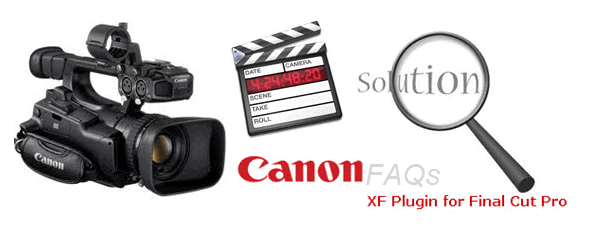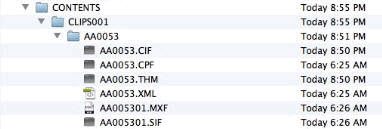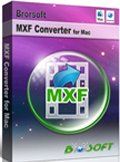Canon XF Plugin for Final Cut Pro (X)| FAQs & Answers
Canon has introduced Canon's XF Plugin for Final Cut Pro along with the Canon XF Utility. This is a plug-in software for Final Cut Pro. This plug-in allows you to use the Log and Transfer function to edit movies captured with the XF camcorders. Later, it also developed Canon XF Plugin for Final Cut Pro X, wihch is a plug-in software for importing media from compatible XF and Cinema EOS cameras XF305, XF300, XF105, XF100 and C300 directly into Final Cut Pro X.
Canon XF plugin for Final Cut Pro helps Cannon users a lot while importing Canon .MXF footage into Final Cut Pro. However, users still have problems one or another when utilizing the software on Mac OS X. We have a collection of frequently asked questions about Canon XF Plugin for Final Cut Pro here, and aim to provide available solutions to these issues.

FAQs & Answers for Canon XF Plugin for Final Cut Pro (X)
FAQ 1: Canon C300 to FCP 7-“We are using FCP 7, and as far as I know it does not read Canon C300 files natively. We tried Canon XF Plugin for Final Cut Pro, with very limited success, on few different machines. Main problem with that piece of software is that it expects to see compact flash cards straight from the camera and doesn’t seem to work very well with folders on an HDD. Is there a recommended workflow for us to move MXF files from an HDD to FCP 7?”
Answer: It is strongly suggested to convert MXF clips to Apple ProRes 422 using Brorsfot MXF Converter for Mac software, because FCP 7 needs to have all the footage on a timeline in the single codec, otherwise it needs to render everything and does not preview clips in realtime. The Canon MXF Convert for Mac tool is able to load MXF files directly from your camera, or read from a folder stored on your computer’s HDD or an external hard drive, as well as separate .MXF clips out of the camera’s original folder structure. Plus, this solution is particular helpful when you need combine footage coming from different cameras with different video modes. Best of all, it is capable of keeping multiple audio tracks in your source material.
FAQ 2: Canon XF100 to FCP 7-“Hi, I am about to begin editing a film shot on Canon XF100. I have a hard-drive onto which all of the raw files were dumped, and am now trying to find a way of working with the files. As far as I can make out everything was copied as it should be (i.e. with the directory structure intact):

I have installed the Canon XF plugin for FCP. Problems arise when I try to use Log & Transfer to transcode the MXF material. I have tried Native/Pro Res 422/ ProRes LT/in fact all of the options from the drop down destination menu, and keep getting the same problem: namely, that about 80-90 percent of files are only transcoded in part. What I mean is that a 5 minute clip ends up as only 10 seconds. I have FCP 7.0.3 and the relevant Canon XF plugins…Now I’m at a loss as to what to do… Anyone have any suggestions as to how I can start editing this film on FCP?”
Answer: It seems that Canon XF plugin for FCP somehow messed up when rendering the MXF media for use in Final Cut Pro 7. We heard people have troubles with EOS plugin of similar nature. Can we L&T footage without utilizing Canon plugin? Actually, there are a large number of Canon MXF to FCP converter programs claiming to be good at transcoding MXF media files to ProRes 422 for FCP. The thing is that it’s difficult to make audio and video always in sync in the generated ProRes MOV files. As for video and audio synchronization, Brorsoft Canon MXF Converter does a good job. So, it’s wise to use this software for MXF to FCP ProRes codec conversion.
FAQ 3: Canon C300 to FCP X-“I especially get confused when I need to download the Canon plug-in for Final Cut Pro X from the Canon site, which is a real mess! I have MXF footage shot on the Canon C300 and I’m trying to convert it from true 24p to ProRes 422(HQ) 23.976. Does anyone know an easy-to-use converter to do this?”
Answer: Brorsoft’s Canon MXF Converter will shed you some light on this problem. More than encoding true 24p C300 MXF files to ProRes 422(HQ) 23.976, it can also rewrap MXF to PrpRes 422, ProRes LT, ProRes Proxy, and ProRes 4444 to fit different FCP use.
FAQ 4: Canon XF305 to Final Cut Pro-“I’ve run into a problem with a project. I copied the entire card file structure of XF305 onto a hard drive, installed all the right codecs…and Final Cut telling me the file structure is invalid.”
Answer: You may have destroyed your original file structure of XF305 yet. If you have the similar trouble likewise or some other unknown errors when editing Canon MXF clips, we always have workaround to deal with these incompatible issues. Simply convert MXF files recorded by a Canon camera to Apple ProRes 422 via using a Canon MXF to ProRes 422 Converter, which is the simplest and most effective solution for you.
Overall, we can make a conclusion as long as you have the versatile MXF Converter, it will be possible to let Final Cut Pro (X) touch MXF material shot on a Canon XF305/XF300/XF105/XF100 and C300 camera even without utilizing Canon XF plugin and long with smooth importing and editing work.


Related guides:
Edit Canon C300 MXF in Premiere Pro
Edit Canon C300 MXF footages in FCE
Put Canon C300 MXF footages in iMovie'11
How to open Canon MXF files in Sony Vegas
How to import Canon MXF Footages to iMovie
Convert Canon C300 MXF files to Sony Vegas Pro
Import Canon C300 MXF files to Adobe After Effects
How to ingest Canon MXF files to Avid Media Composer
Useful Tips
- Convert MXF to MOV
- Play MXF in VLC
- Play MXF in Media Player
- Upload MXF to YouTube
- Convert MXF to AVI/WMV/MPEG
- Transcode P2 MXF to ProRes
- Import MXF to After Effects
- Convert Canon MXF to Avid
- Import MXF to iMovie
- Convert MXF to Premiere
- Convert MXF for Mac editing
- Convert MXF to Pinnacle Studio
- Convert MXF to PowerDirector
- Load Sony MXF to Final Cut Pro
- Edit MXF files with Davinci Resolve
- Sync MXF with Pluraleyes 3/3.5/4
- Edit MXF in Camtasia Studio 8/7
- Convert MXF to Windows Movie Maker
Adwards

Copyright © 2019 Brorsoft Studio. All Rights Reserved.







